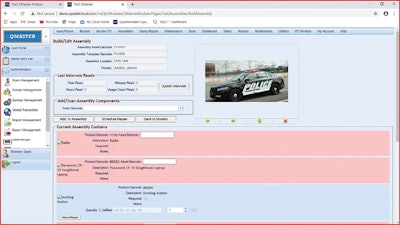 Omnigo’s QueTel Quartermaster software tracks the complete inventory of the agency’s equipment, including vehicles and all of the gear inside them. (Photo: Omnigo)
Omnigo’s QueTel Quartermaster software tracks the complete inventory of the agency’s equipment, including vehicles and all of the gear inside them. (Photo: Omnigo)
Prudent inventory management for law enforcement agencies requires a comprehensive process and accountability for uniforms, supplies, and equipment from receipt to disposition.
Simple manual paper-driven procedures or spreadsheets are insufficient to hold officers accountable for issued items, much less controlling stocking levels in separate storage rooms. Agencies can benefit from using more advanced tools to unify how they manage inventory and maintenance, especially for mission-critical equipment.
Omnigo’s QueTel Quartermaster software provides a complete inventory system that law enforcement agencies can use to easily manage all shelf stock in multiple locations, including vendor-supplied equipment. It alerts managers of stock replacement, expiration, end-of-warranty dates, inspections, maintenance records, and calibration schedules and checklists. The all-encompassing online store provides users with an Amazon-like remote order capability.
THE PROBLEM
Taking a comprehensive approach to inventory management is difficult for most agencies because separate units manage the stock room, vehicles, radios, laptop/MDTs, firearms, TASERs, smartphones, video cameras, communications equipment, and much more.
Many departments still use spreadsheets, written logs, and other manual methods for tracking everyday inventory requirements. And while paper files and spreadsheets provide a semblance of control, they do not offer comprehensive accountability, nor do they offer one unified platform for viewing the usage and location of all equipment, uniforms, and supplies. A manual approach can be cumbersome, expensive, and complicated for the budgeting, procurement, stocking, and ongoing management of all departmental assets.
THE SOLUTION
Deploying an automated inventory management platform can help law enforcement agencies increase efficiency and reduce costs simultaneously.
With various equipment and supplies to manage, department leaders can simplify and streamline inventory management by developing a strategy and securing a technology solution that focuses on the following critical areas:
•Alerting the appropriate staff of equipment expiration
• Avoiding out of stock situations
• Stocking the optimal inventory levels that meet the department’s current and ongoing needs
• Managing the cost of inventory and tracking assets provided through grants
• Ensuring accountability in asset issuance and return by effectively managing equipment check-in and check-out
• Streamlining the asset ordering and management process, eliminating paper-based tracking, and automating inventory management responsibilities
For departments that are new to automated inventory management, the immediate improvements in centralized inventory control and accountability can be significant. A manual inventory management process could be costing your department time and money in ways you may not have even considered—from storage and overstock expenses to accountability deficiencies and compromised equipment safety.
By maintaining the right inventory levels at all times, officers can access supplies and equipment where and when they need them. A solution that utilizes updated barcode and serial number scanning technology can be beneficial in increasing efficiency.
For the typical department, inventory management includes three critical components: assets, quantities, and locations, which could range from station supplies such as personal protective equipment, uniforms, weapons, protective gear, medical supplies, and rescue equipment. These serialized and bulk supplies need to be continually replenished and located in places where they are readily accessible to supervisors and officers.
Inventory automation and alerts can notify staff when:
• Asset levels are depleted and require re-order
• Assets are nearing warrantyexpiration
• Supplies require replacement due to potential functional deficiencies
• Equipment maintenance is needed (optional)
Proper inventory management helps staff control stock storage, eases the check-in/check-out process, and ensures that supplies are available when responders need them.
Additional benefits include the opportunity to reduce risks, eliminate paperwork, and maximize performance by ensuring that responders have appropriate operational equipment.
To best optimize your inventory management system, you should first evaluate your current process of stocking, ordering, and managing all products for your department and identify what is on the shelves, where it is stored, and who is involved in the ordering process. You can then quickly load this information into your Quartermaster software.
When you know everything your agency has on hand and who has it, you can better manage supplies and reduce costs by eliminating waste and inefficiency. Officers need to be able to access the right assets at the right time.
By focusing on existing stock, asset turnover, and order history, departments can immediately save time and formulate future year budgets more accurately. An automated inventory management solution helps you review and update your procurement plans, so it aligns with your department’s emerging needs.
Department leaders can leverage an inventory management solution to minimize their most pressing inventory challenges, helping law enforcement staff and emergency responders perform their jobs more safely and cost-effectively.
CASE STUDY
A Texas law enforcement agency wanted to increase accountability and save time associated with tracking everything manually. The department reported that different divisions within the agency kept separate records. A third or more did not maintain any history of repairs, maintenance, or inspections to radios, weapons, and IT equipment like laptops and tablets.
With Omnigo’s Quartermaster software, the department saved time, eliminated paper, and maintained a centralized record for inventory, assignment, and cost management.
Keeping track of everything in one system also helped it eliminate gaps and reduce the potential for error. Each unit responsible for managing various types of equipment, as well as uniforms and supplies, now uses the same software to manage inventory levels, to track what each officer or deputy is responsible for, and to project future budgets.
For more information, visit omnigo.com or call (866) 421-2374.
Bettina Martinez is the marketing manager at Omnigo.
